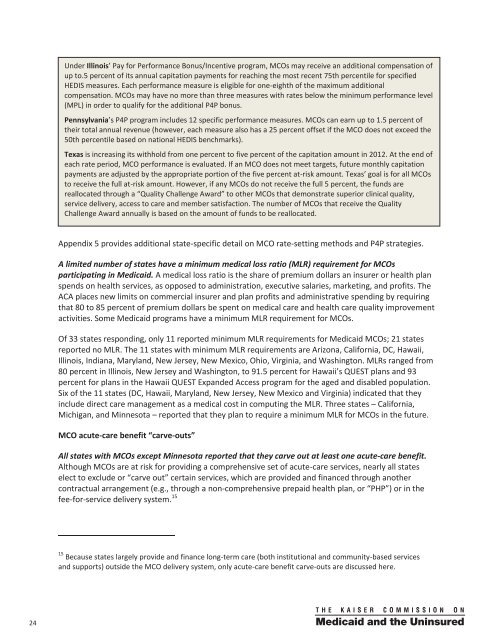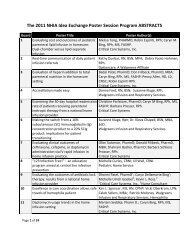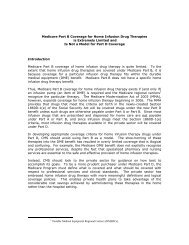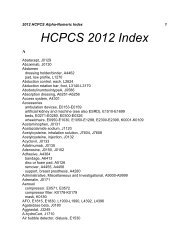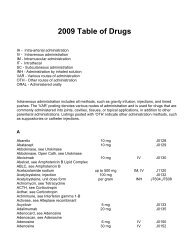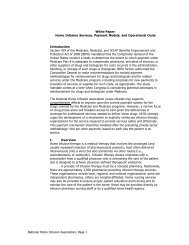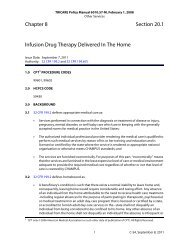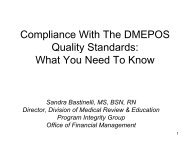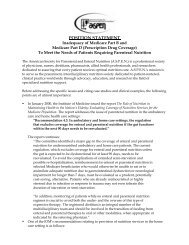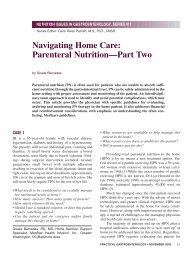Kaiser Family Foundation Survey on State Medicaid Managed Care ...
Kaiser Family Foundation Survey on State Medicaid Managed Care ...
Kaiser Family Foundation Survey on State Medicaid Managed Care ...
- No tags were found...
You also want an ePaper? Increase the reach of your titles
YUMPU automatically turns print PDFs into web optimized ePapers that Google loves.
Under Illinois’ Pay for Performance B<strong>on</strong>us/Incentive program, MCOs may receive an additi<strong>on</strong>al compensati<strong>on</strong> ofup to.5 percent of its annual capitati<strong>on</strong> payments for reaching the most recent 75th percentile for specifiedHEDIS measures. Each performance measure is eligible for <strong>on</strong>e-eighth of the maximum additi<strong>on</strong>alcompensati<strong>on</strong>. MCOs may have no more than three measures with rates below the minimum performance level(MPL) in order to qualify for the additi<strong>on</strong>al P4P b<strong>on</strong>us.Pennsylvania’s P4P program includes 12 specific performance measures. MCOs can earn up to 1.5 percent oftheir total annual revenue (however, each measure also has a 25 percent offset if the MCO does not exceed the50th percentile based <strong>on</strong> nati<strong>on</strong>al HEDIS benchmarks).Texas is increasing its withhold from <strong>on</strong>e percent to five percent of the capitati<strong>on</strong> amount in 2012. At the end ofeach rate period, MCO performance is evaluated. If an MCO does not meet targets, future m<strong>on</strong>thly capitati<strong>on</strong>payments are adjusted by the appropriate porti<strong>on</strong> of the five percent at-risk amount. Texas’ goal is for all MCOsto receive the full at-risk amount. However, if any MCOs do not receive the full 5 percent, the funds arereallocated through a “Quality Challenge Award” to other MCOs that dem<strong>on</strong>strate superior clinical quality,service delivery, access to care and member satisfacti<strong>on</strong>. The number of MCOs that receive the QualityChallenge Award annually is based <strong>on</strong> the amount of funds to be reallocated.Appendix 5 provides additi<strong>on</strong>al state-specific detail <strong>on</strong> MCO rate-setting methods and P4P strategies.A limited number of states have a minimum medical loss ratio (MLR) requirement for MCOsparticipating in <strong>Medicaid</strong>. A medical loss ratio is the share of premium dollars an insurer or health planspends <strong>on</strong> health services, as opposed to administrati<strong>on</strong>, executive salaries, marketing, and profits. TheACA places new limits <strong>on</strong> commercial insurer and plan profits and administrative spending by requiringthat 80 to 85 percent of premium dollars be spent <strong>on</strong> medical care and health care quality improvementactivities. Some <strong>Medicaid</strong> programs have a minimum MLR requirement for MCOs.Of 33 states resp<strong>on</strong>ding, <strong>on</strong>ly 11 reported minimum MLR requirements for <strong>Medicaid</strong> MCOs; 21 statesreported no MLR. The 11 states with minimum MLR requirements are Ariz<strong>on</strong>a, California, DC, Hawaii,Illinois, Indiana, Maryland, New Jersey, New Mexico, Ohio, Virginia, and Washingt<strong>on</strong>. MLRs ranged from80 percent in Illinois, New Jersey and Washingt<strong>on</strong>, to 91.5 percent for Hawaii’s QUEST plans and 93percent for plans in the Hawaii QUEST Expanded Access program for the aged and disabled populati<strong>on</strong>.Six of the 11 states (DC, Hawaii, Maryland, New Jersey, New Mexico and Virginia) indicated that theyinclude direct care management as a medical cost in computing the MLR. Three states – California,Michigan, and Minnesota – reported that they plan to require a minimum MLR for MCOs in the future.MCO acute-care benefit “carve-outs”All states with MCOs except Minnesota reported that they carve out at least <strong>on</strong>e acute-care benefit.Although MCOs are at risk for providing a comprehensive set of acute-care services, nearly all stateselect to exclude or “carve out” certain services, which are provided and financed through anotherc<strong>on</strong>tractual arrangement (e.g., through a n<strong>on</strong>-comprehensive prepaid health plan, or “PHP”) or in thefee-for-service delivery system. 1515 Because states largely provide and finance l<strong>on</strong>g-term care (both instituti<strong>on</strong>al and community-based servicesand supports) outside the MCO delivery system, <strong>on</strong>ly acute-care benefit carve-outs are discussed here.24 00


